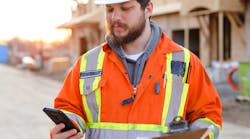Companies that employ essential workers, including union members, have come up with various ways to manage onsite health screenings. Almost everybody does a temperature check on arrival. For the next step, which is asking COVID-19-related health questions, some companies assign administrators to interview employees and record their answers on a sheet that’s later input into an HR system. This holds up productivity while employees wait in line trying to keep six feet apart. Other companies ask employees to complete their own health screenings and submit their answers on a .pdf that gets emailed to their supervisor and HR.
Managing those records is next to impossible. Sorting through the files, cross-checking them with employee time sheets, and expecting to sufficiently identify and alert employees to potential exposure to COVID-19 in a timely way is unrealistic, not to mention the potential HIPAA violations.
Employers, and smart technology companies, quickly realized the frailties in these approaches. That’s why there’s been an uptick in digital check-in apps for COVID-19. These apps streamline the health screening process by having employees log in via their smartphones to answer questions based on CDC guidelines and local mandates. And they’re simple to use. Essentially, an employee walks up to a designated check-in area, points their smartphone at a QR-coded poster to check in, and answers questions for the health screening. They get instant notification on whether they’re allowed to enter their site. Their boss and HR also get real-time alerts.
The digital check in process minimizes all of the issues associated with an admin interview at the start of the shift, including the potential for human error. It also enables employers to keep a secure digital record of employees who have been denied access to a site so they can take action and, if necessary, do contact tracing.
The upside of employees using these smartphone apps is that they can manage their own personal health information. Also, the employer doesn’t have to take on the expense and risk of knowing employee health information. If they need to do contact tracing, they can align phone identification data with check-in records and still never see responses to the health questions. Their only concern is that worksites are safe and not a source for passing COVID-19.
Streamlining Check-In Protects Employees and Employers
After using digital-check in for several months, there are additional, unexpected benefits that are of interest to EHS officers, construction supervisors, and union stewards.
Streamlining the check-in process at the start of the day reduces admin and allows employees to get projects done faster. This isn’t about adding additional responsibilities to employees or extending the day for health screenings due to the pandemic. Rather, it’s about eliminating the shared tablet or paper-based sign-in sheets, which are still used on many construction sites. For some projects, the time savings from digital check-ins can be anywhere from two to four hours a day.
The digital records also let you know who is on site at any given moment, including visitors. Eliminating the visitor logbooks and requiring digital check-ins keeps work environments safer. This is especially important in the event of an emergency and you need to know who is still onsite or in the building.
When it comes to avoiding fines, digital check-ins are critical in several ways. For example, if someone contracts and spreads COVID-19 at work, employers need a way to confirm if the virus can be tracked to the job site. When employees check in and are granted access, it’s based on the assurance that they are symptom-free.
For businesses like construction that need to comply with OSHA regulations, a job site outbreak must be reported. As the days the employee(s) are away from work add up, the higher the likelihood of the employer being fined. If the incidents hit a certain number, the construction company could be blocked from bidding on certain jobs for three years.
Additionally, the digital check in creates a time stamp for employees and subcontractors. When union dues are owed, or invoices don’t match hours worked, or there are other needs such as claims that require accurate daily login information, there’s a digital record for verification.
Designed for a Post-Pandemic Work Environment
Digital check-ins can offer more than pandemic-related health screenings, but only if the apps are flexible enough to support the needs of a dynamic workforce. For example, once a vaccine is available, the COVID-19 health checks may be replaced with other safety-related questions about daily project tasks. Additionally, employers with a diverse workforce may require the app to support multiple languages to ensure all communications are understood by every employee.
In construction, as one project finishes and another one starts, an administrator should be able to quickly set up a new check-in area without requiring the IT department get involved.
These new digital check-in apps which emerged from the pandemic are going to play a big role in the way we ensure the health and safety of employees as we adjust to new ways of working.
Kyle Peacock is CEO of Peacock Construction, a San Francisco-based construction company.
